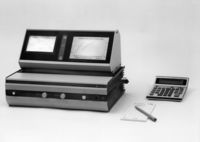| The realization that the color-grade of a diamond can be
derived from the absorption ratio in the blue and yellow
wave-length regions, led LENZEN in 1969 to develop the
Diamond¬Phot0meter (Fig, 13), The Diamond photometer measures
the transparency for monochromatic blue and yellow light, whence
the absorption can be calculated. Fig, 14 shows the path of a monochromatic light ray in a brilliant after it has been passed through an interference filter. |
 Fig 13 Diamond Photometer (Eickhorst system) |
 Fig 14 Diagram Showing the path of a ray of light through a brilliant for measuring the transmission. |
The light ray enters the table of the stone with an intensity of I0 = 100 % and travels within the brilliant by two total reflections from the pavilion facets to emerge again through the crown facets. Its intensity, diminished by absorption (= transmission), is measured on a photo-electronic receiver. From this the ratio T2 for the yellow wave-length and T1 for the blue wave-length is calculated: T2:T1 |
The transmission values of the two wave-lengths used yield the transmission quotient. The greater this is, the yellower is the color effect.
The proportional figure lies in the region of 080 to 500 and is always registered on only one instrument, so that reproducibility of the result (i.e. the proportional figure) is always only possible on the same instrument. By means of an empirically developed measuring graph on the instrument the transmission quotient can be converted into one of the usual trade color-grades This last result is once more the same on all instruments.
In practical use the Diamond-Photometer has not justified itself. In the end it is apparent that the human eye can carry out color comparison considerably more certainly and more accurately because, in the course of grading, It can take into account the following properties in their totality.
- color - Transparency - Luster - Fluorescence - Proportions - Mixed hues
The Diamond-Photometer IS not capable of this. It can therefore never be
more than an accessory aid to color-grading. In the hands of those who
are aware of the sources of error of the Photometer and who know how to
take them into account, it may serve as a decisive aid in borderline
cases. But the visual impression remains the deciding factor.
| Remission Spectrophotometer | Artificial color Changes in Diamonds and their Method of Identification |